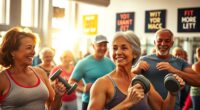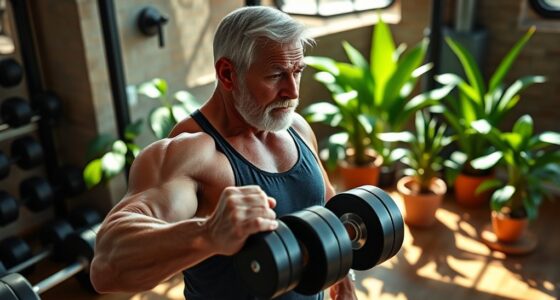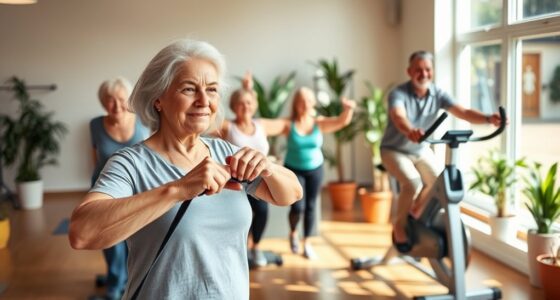Engaging in simple exercises can greatly improve your quality of life as you age. Activities like knee lifts, walking heel to toe, and chair yoga enhance balance and mobility. Incorporating low-impact cardio, such as walking or water aerobics, keeps your heart healthy. Don’t forget about strength training and flexibility exercises, too. These practices can boost your mood and support independence in daily activities. Explore more ways to enhance your physical health and well-being.
Key Takeaways
- Regular walking for 10-20 minutes daily boosts mood and oxygen utilization, enhancing overall well-being.
- Gentle exercises like chair yoga improve flexibility and lower body strength.
- Balance exercises, such as single-leg stands, reduce the risk of falls and enhance stability.
- Engaging in community classes fosters social connections and motivation for consistent exercise.
- Incorporating low-impact activities, like water aerobics, minimizes joint stress while promoting cardiovascular health.
Benefits of Regular Exercise for Seniors

When you engage in regular exercise, you’re not just staying active; you’re also greatly enhancing your quality of life.
For older adults, the health benefits of exercise are essential. Regular physical activity can improve balance and build stronger muscles, which helps reduce falls by 23%, a major concern for many seniors. Additionally, safe sleep practices can support recovery and overall health by ensuring seniors get the rest they need. Furthermore, financial considerations for elderly care highlight the importance of planning for potential healthcare costs associated with maintaining an active lifestyle. Engaging in exercise also cultivates resilience and learning, which can empower seniors to overcome various life challenges. Moreover, maintaining a routine similar to stability through rules can provide a sense of structure that promotes consistency in physical activity.
In addition, exercising boosts mental health by releasing endorphins that combat fatigue and enhance overall well-being. It also plays a pivotal role in preventing diseases like heart disease and diabetes, promoting a healthier lifestyle as you age.
Moreover, exercise contributes to cognitive health, considerably lowering the risk of developing Alzheimer’s disease. Additionally, creating living spaces that enhance quality of life can further support an active and fulfilling lifestyle for seniors.
Gentle Exercises to Enhance Mobility

Regular exercise is a key component of maintaining independence and enhancing mobility as you age. Gentle exercises, like knee lifts and walking heel to toe, can markedly improve balance and coordination, reducing the risk of falls. Incorporating simple balance exercises, such as single-leg stands and tandem stance, helps strengthen your stability, making you feel more confident while walking. Engaging in low-impact activities like static biking or rowing workouts can boost overall mobility without straining your joints. Additionally, practicing chair yoga and gentle leg exercises, such as half squats and side leg raises, not only enhances lower body strength but also improves flexibility. According to experts, safe sleep environments can significantly contribute to a person’s overall health and well-being. Including antioxidant-rich foods in your diet can further support cognitive function, which is essential for maintaining an active lifestyle. Adding these routines to your daily practice can greatly enhance your overall well-being, making everyday tasks easier and safer. Furthermore, pet therapy can provide companionship and emotional support, which is particularly beneficial for elderly individuals facing feelings of isolation. Regular participation in these activities may lead to improved user experience as it fosters a greater sense of independence and well-being. Moreover, engaging in digital literacy programs can enrich social interactions and help alleviate feelings of isolation among seniors, providing a positive boost to their mental health.
Strengthening and Balance Activities

Strengthening and balance activities are essential for maintaining your independence and overall health as you age. Engaging in strength training exercises like chair yoga and gentle leg lifts can improve lower body strength, enhancing muscle mass and bone density. Additionally, it’s important to consider your sexual health risks as you age, as certain conditions may affect your physical activity levels. Regular engagement in these activities can help you overcome fear of losing mobility and independence. Research shows that older adults who participate in regular exercise can benefit from stronger emotional support as they navigate life changes. Furthermore, planning ahead with estate planning can ensure your wishes are respected as you age.
Strength training and balance exercises are vital for preserving independence and health as you age.
Incorporating balance activities such as single-leg stands and tandem stance exercises markedly reduces the risk of falls by improving stability and coordination. You can also enhance mobility with dynamic movements like marching in place and heel-to-toe walking. Performing exercises like Rock the Boat and side leg raises boosts lateral strength, vital for daily tasks. Regular exercise not only supports elderly health but also leads to increased energy levels and a lower risk of chronic diseases. Additionally, maintaining nutritional balance through a healthy diet complements these physical activities for overall well-being.
Prioritize these activities for a healthier, more active life.
Safe Cardio Workouts for Older Adults

As you focus on building strength and balance, incorporating safe cardio workouts can further enhance your overall well-being.
These activities are essential for older adults to improve cardiovascular health and maintain independence. Consider these options:
- Walking Exercises: Start with gentle walks for 10 to 20 minutes daily to boost mood and oxygen utilization. Connecting with nature during these walks can also enhance your sense of home and heritage. Regular walking can significantly contribute to enhancing life at home by providing both physical and mental health benefits. Additionally, engaging in regular exercise can lead to improved cardiovascular health and overall fitness. Adding camping locations to your walking routes can provide a scenic backdrop that motivates you to stay active.
- Low-Impact Activities: Engage in water aerobics or stationary cycling to minimize stress on joints while providing a full-body workout.
- Community Classes: Join a walking group or other community classes to foster connection and motivation.
Regular moderate aerobic activity can reduce the risk of chronic diseases like heart disease and diabetes by nearly 50%, helping you enhance endurance and stay active longer. Additionally, incorporating portable camping toilets during outdoor activities can ensure comfort and convenience while engaging in exercise.
Creating a Sustainable Exercise Routine

Creating a sustainable exercise routine is key to maintaining your health and independence as you age. Aim for at least 150 minutes of moderate aerobic activity weekly, like walking or swimming, and include strength training twice a week.
Here’s a simple structure to take into account:
| Exercise Type | Frequency |
|---|---|
| Moderate Aerobic Activity | At least 150 minutes/week |
| Strength Training | 2 days/week |
| Balance Exercises | 2-3 times/week |
| Flexibility (e.g., Tai Chi) | 2-3 times/week |
Break sessions into 10-15 minute chunks to fit your energy levels. Don’t forget to track progress and adjust your regimen based on your health conditions, ensuring it remains effective and safe. Incorporating safety and durability into your exercise equipment choices can further enhance your routine for longevity.
Frequently Asked Questions
What Is the Number One Exercise Seniors Should Do?
The number one exercise you should do is the Sit-to-Stand. It’s simple yet effective for enhancing your lower body strength and functional mobility.
By performing two to three sets of 10 repetitions regularly, you’ll improve your balance and reduce the risk of falls. This exercise targets key muscle groups, like your quadriceps and glutes, which are essential for maintaining independence.
Plus, it boosts your confidence in movement and overall mobility.
What Is the Number 1 Exercise to Increase Balance in Seniors?
You might think balance exercises are only for athletes, but they’re essential for everyone, especially seniors.
The number one exercise to increase balance is the Tandem Stance. By standing with one foot directly in front of the other, you’ll challenge your stability and engage your core.
Try holding this position for 30 seconds. As you progress, you can eliminate support or add weights. Regular practice will boost your confidence and everyday independence.
What Type of Exercise Is Good for Old Age?
In old age, low-impact exercises like walking, swimming, and cycling are great for your cardiovascular health without stressing your joints.
Strength training’s essential too, as it helps maintain muscle mass and bone density.
Don’t forget balance exercises, like tai chi, which enhance stability and reduce fall risks.
Flexibility routines, including chair yoga, improve your range of motion.
Aim for at least 150 minutes of aerobic activity weekly to boost your overall health and energy levels.
What Exercise Should a 70 Year Old Do Every Day?
They say, “A journey of a thousand miles begins with a single step.” For you, that means incorporating daily exercises that boost your health.
Aim for at least 30 minutes of moderate aerobic activity, like brisk walking or swimming, spread across manageable sessions.
Don’t forget to include balance exercises, gentle stretches, and strength training twice a week.
These activities will enhance your stability, flexibility, and overall well-being, helping you stay active and independent.
Conclusion
Incorporating regular exercise into your daily routine can be the key that releases a healthier, more vibrant life. By embracing gentle movements, balance activities, and safe cardio, you not only enhance your mobility but also boost your overall well-being. Remember, consistency is the glue that holds your progress together. So, lace up those sneakers and take the first step—your future self will thank you for it, and you’ll find joy in every stride.









